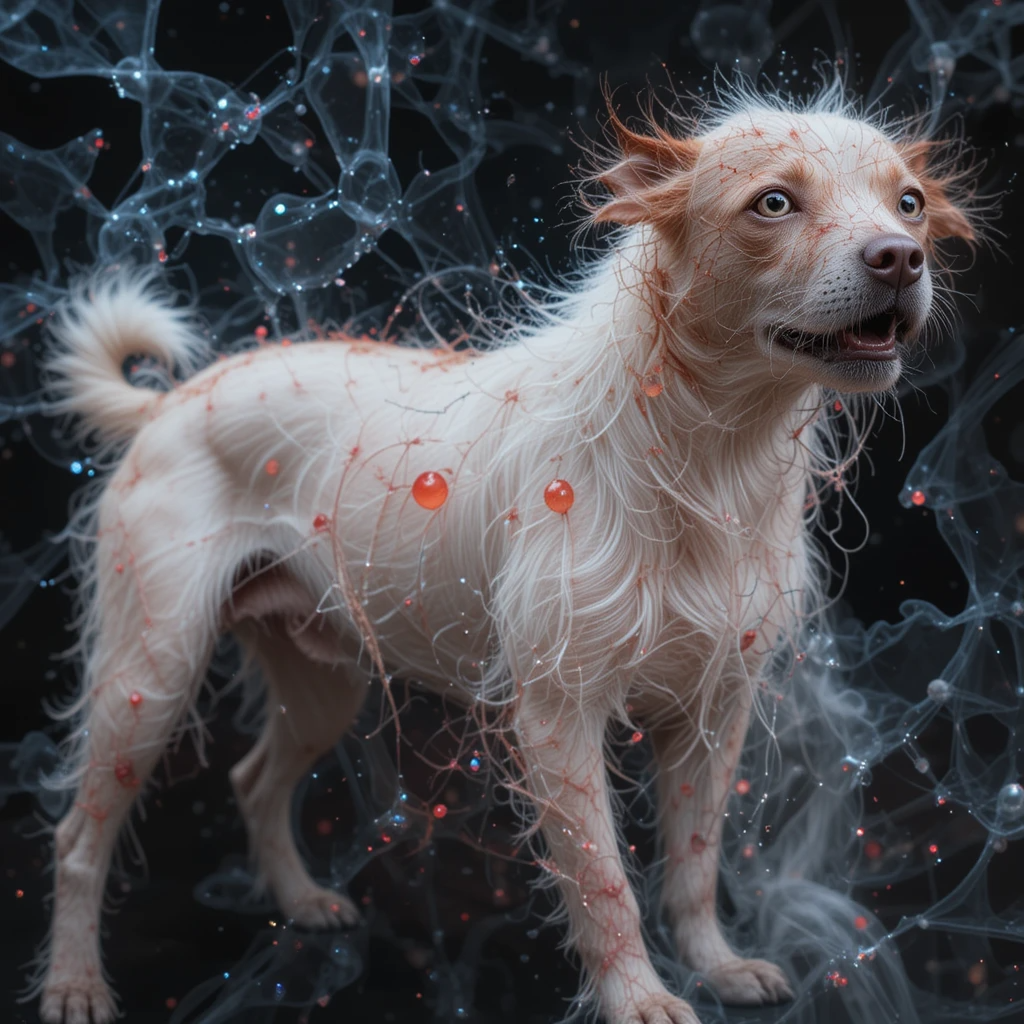Chemical castration in dogs is becoming a popular option for dog sterilisation. This method involves implanting a hormonal chip, like Suprelorin, under the dog’s skin. The process is similar to microchipping and doesn’t require anaesthesia, making it a less invasive alternative to traditional surgical neutering. One of the best parts about chemical castration is that it is fully reversible, which gives pet owners more flexibility. The procedure is simple, fast, and helps manage unwanted behaviours linked to hormones, while still ensuring your dog stays healthy. It’s a contemporary and effective approach to sterilisation, especially for those who prefer non-surgical methods.
The fact that chemical castration is reversible adds an extra benefit, especially for pet owners unsure about permanent procedures. This method is gaining popularity among pet owners who want an alternative to the usual surgical options for dog sterilisation. With advancements like Suprelorin, it’s now easier to help manage your dog’s hormonal behaviours without surgery. Plus, it’s a great option for those who are looking for a less invasive solution that doesn’t disrupt the dog’s well-being.
Table of Contents

Understanding Chemical Castration in Dogs
How Chemical Castration Works
Chemical castration works by suppressing testosterone production in male dogs. This is done through hormonal implants or injections, which lead to temporary sterilisation. By reducing the hormone, it helps manage behaviours related to testosterone, such as marking and aggression. This procedure is considered a non-invasive alternative to surgical neutering. Chemical castration is a reversible method, giving pet owners flexibility when deciding whether to continue with the treatment or not. It’s a useful option for those seeking to manage their dog’s behaviour without permanent sterilisation.
The hormonal implants or injections used in chemical castration are effective in temporarily controlling testosterone levels, thus preventing unwanted behaviours. As a non-surgical method, it’s often seen as a less invasive option compared to traditional neutering. This method has gained popularity because it offers the same benefits of sterilisation while allowing for reversibility. Whether you are considering it as a behaviour management strategy or as a temporary solution, chemical castration provides an alternative to surgery that many pet owners appreciate.
Suppression of Testosterone Production
Chemical castration works by reducing testosterone production in male dogs. This is achieved by administering medications like gonadotropin-releasing hormone (GnRH) agonists, which block testosterone and help in fertility control. One of the most commonly used methods is the Suprelorin implant, which gradually releases Deslorelin, the active ingredient that suppresses testosterone over time. This procedure helps manage certain dog behaviours, such as unwanted sexual behaviour and marking, by reducing the dog’s hormone levels without requiring surgery. The treatment is a non-surgical and reversible alternative to traditional neutering.
The medication works by suppressing testosterone in a controlled manner, leading to a reduction in sexual behaviours and improving overall dog behaviour management. Because the process is reversible, it offers flexibility to pet owners who may want to reconsider the treatment in the future. Over time, Deslorelin effectively manages hormonal issues without invasive surgery, providing a solution for those looking for a temporary alternative to neutering.
The Duration and Effectiveness
Chemical castration in dogs works through a process where hormonal devices are used to manage how long the treatment lasts. Typically, the duration of its effectiveness is either 6 months or 12 months, depending on the type of implant used. Once the implant is placed under the dog’s skin, it slowly releases a medicine called Deslorelin, which works by stopping the production of testosterone in the dog’s body. This method helps reduce hormonal-driven behaviours like aggression and marking, providing a non-surgical option for fertility control.
The effectiveness of chemical castration lies in how the medication gradually works to control testosterone. It is a controlled, less invasive alternative to traditional neutering, offering flexibility for pet owners who want a temporary solution. The Deslorelin slowly suppresses testosterone production, and the treatment can last for several months, giving pet owners a chance to assess if this method works for their dog. With chemical castration, dogs can benefit from behaviour management without the need for permanent surgery.
Behavioural Changes and Side Effects
Chemical castration is often used by dog owners to manage certain behavioural issues linked to male sex hormones, such as aggression, urine marking, and humping. While chemical castration can significantly reduce these behaviours, it’s important to understand that it’s not a replacement for proper training and socialisation. Dogs still need consistent training to reinforce positive behaviour and improve their interactions with people and other animals.
It’s also essential to be aware of potential side effects that may occur with chemical castration, such as changes in coat quality, appetite, and activity levels. While the procedure can help reduce hormone-driven behaviours, these physical changes might be noticeable in your dog’s overall condition. As with any treatment, it’s important to monitor your dog’s health and ensure they receive proper care alongside the procedure.

Surgical vs. Chemical Castration
When deciding between chemical castration and surgical castration, several factors need to be considered. This includes whether the dog owner plans to breed their pet in the future, concerns about permanent behavioural changes, and the dog’s overall health status. One of the main benefits of chemical castration is that it is fully reversible and doesn’t require anaesthesia, making it a good option for dogs who may have health issues that make them unsuitable for surgery. This non-surgical alternative offers a temporary solution for reproductive control.
Chemical castration uses hormone therapy, which allows for reproductive control in male dogs without causing lasting changes to their endocrine system. This method offers an effective, non-surgical way to manage reproductive health in dogs, providing flexibility for owners who want a temporary solution. While surgical castration involves permanent changes, chemical castration gives owners the ability to reverse the process if needed. This makes it a great option for those unsure about a permanent procedure.
Making the Right Decision
When considering chemical castration for your dog, it’s important to weigh the pros and cons before making a decision. This method is ideal for dog owners who may want to breed in the future but are unsure about committing to a permanent change. If you’re not planning to breed your dog, opting for castration—whether chemical or surgical—can be a wise choice. It helps to prevent unwanted breeding and can also help manage specific behavioural issues like aggression or marking, which are often linked to hormonal drives.
Choosing chemical castration offers a reversible solution that provides flexibility for pet owners. For dogs that may not be suitable for surgery due to health reasons, chemical castration can be a non-invasive alternative that addresses both reproductive health and behavioural control. Whether your dog is showing unwanted behaviours or you just want to manage their reproductive health, this method gives you the ability to assess the situation without making a permanent decision.
Pros and Cons of Chemical Castration
Chemical castration is a non-surgical and temporary method of dog sterilization that offers several advantages and disadvantages. One of the main benefits is that it’s a non-invasive option, which reduces the risk associated with anaesthesia and surgery. This makes it a safer choice for dogs that may have health concerns. Another advantage is that chemical castration is reversible, allowing for future breeding if the dog owner chooses to breed their pet later. It also helps manage behaviours like aggression and roaming, and it eliminates the risk of testicular cancer. The effectiveness usually lasts for 6 to 12 months, providing flexibility and convenience for pet owners.
However, chemical castration does have its drawbacks. It is a temporary solution and requires repeated treatments over the dog’s lifetime. It also takes time to become effective, making it less immediate compared to surgical castration. Some hormonal fluctuations could occur, leading to unpredictable behavioural impacts. Additionally, chemical castration may not be as effective in reducing the risk of prostate disease when compared to surgical neutering. The cost of repeated treatments can add up over time, making it a more expensive option in the long run.
Factors to Consider Before Opting for Chemical Castration
When thinking about chemical castration for your dog, there are several important factors to consider. One of the key aspects is canine fertility control. If you’re considering future breeding or unsure about making a permanent change, this option may be worth exploring. The cost of chemical castration typically ranges from £100 to £250 in the UK, depending on your vet and the region. It’s essential to weigh this against other available options and understand the financial commitment involved.
Another important factor is the ethical considerations involved in castrating dogs. You should reflect on whether this aligns with your values and if it will benefit your dog’s overall well-being. Consulting a professional, such as a certified dog behaviourist or trainer, is crucial to make an informed decision on the best approach for your dog’s reproductive management and behavioural modification. Additionally, understanding the long-term impact of castration on your dog’s behaviour, including hormone-driven behaviours, anxiety, and overall health, will help you determine whether this is the right choice for your pet.
The Impact of Chemical Castration on Dog Behaviour
Chemical castration can significantly influence certain behaviours in dogs, especially those driven by male sex hormones. For example, humping, urine marking, and aggression often diminish after the procedure. However, it’s important to understand that while this method can aid in reducing these specific behaviours, it is not a complete solution. Comprehensive training and socialization are still essential for effective behaviour management. Without them, other behavioural problems may arise, or the dog’s overall behaviour may not improve as expected.
This is particularly relevant for dog owners dealing with challenges like reactive dog training, fear aggression, or resource guarding. Chemical castration can help control hormone-driven issues, but it doesn’t replace the need for proper behaviour modification techniques. Whether you’re addressing basic behavioural issues or more complex problems, a dog behaviourist or trainer’s guidance is crucial to manage all aspects of your dog’s behaviour effectively.
Enrichment and Training: Essential Complements
While chemical castration can be a helpful tool in managing undesirable behaviours in dogs, it should not be relied upon as the only solution. Regular enrichment activities are vital for dogs’ mental and physical well-being. These activities stimulate their minds and help maintain a healthy body, preventing behavioural problems that could arise from boredom or lack of exercise. Additionally, understanding the role of epigenetics and the environment in shaping a dog’s behaviour is crucial. The environment plays a big part in how a dog behaves and reacts to different situations.
Along with enrichment, training remains a key part of ensuring a dog develops into a well-adjusted pet. In particular, addressing issues like trigger stacking—when a dog becomes overwhelmed by multiple stressors—helps in preventing unwanted behaviours. Both training and enrichment work hand-in-hand to manage your dog’s health and behaviour, complementing the effects of chemical castration and improving your pet’s overall well-being. It’s essential to incorporate all these aspects for a happy, well-balanced dog.

Types of Aggression and Castration
Understanding the different types of aggression in dogs is important when considering chemical castration. While chemical castration can help reduce hormone-driven aggression, it might not be effective for all forms of aggression. For example, some types of aggression are caused by factors other than hormones, such as fear or territorial instincts. This is where it’s essential to understand the difference between genetic and learned behaviours. Some aggressive behaviours may be rooted in the dog’s genetic makeup, while others might develop over time due to experiences or environment.
To fully address aggression, behaviour modification is key. A combination of training, socialisation, and sometimes chemical castration can be effective in managing and reducing aggressive behaviour. Training can help teach the dog proper social skills, while socialisation allows the dog to interact safely with others. Chemical castration may be used when hormonal aggression is a concern, but it should be part of a broader approach that includes behavioural changes through training and socialisation.
Training and Socialisation
The role of training and socialisation is crucial in a dog’s life for managing and shaping their behaviour. While chemical castration can help reduce certain hormone-driven behaviours, it cannot replace the need for proper training practices. Training helps dogs learn basic commands and improve their manners, while socialisation ensures that they interact well with other animals and people. Both elements are essential for ensuring your dog becomes a well-behaved, well-adjusted pet.
A strong owner-dog bond is built through consistent training and positive socialisation experiences. Understanding the ethics and techniques of dog training not only promotes a healthy relationship but also supports behavioural development. By combining chemical castration with proper training and socialisation, dog owners can manage their pet’s behaviours more effectively and improve their overall quality of life.
Behavioural Implications of Neutering and Anxiety in Dogs
When considering neutering, it’s important to recognize the potential behavioural implications it may have on dogs, especially regarding anxiety and fearfulness. While neutering can reduce certain hormone-driven behaviours, it may also lead to an increase in anxiety, particularly in male dogs. This highlights the need for a thorough behavioural assessment before deciding on neutering, especially for dogs who show signs of fear or distress. Rescue organizations like the RSPCA and Dogs Trust have begun to take a more individualized approach to neutering, focusing on each dog’s unique needs, particularly when they exhibit fearful or aggressive behaviours.
The timing of neutering also plays a significant role in a dog’s emotional health. Early neutering has been linked to heightened risks of both fearfulness and aggressive behaviours in dogs. However, these effects can vary depending on factors like genetics and early experiences. As a result, neutering decisions are often now made on a case-by-case basis, sometimes involving referrals to behaviourists for a more comprehensive assessment to ensure the dog’s well-being is properly considered.
Making Informed Decisions
When considering chemical castration for your dog, it’s important to make informed decisions. Early neutering may come with risks, including an increased chance of fearfulness and aggression in dogs. Understanding these risks can help pet owners make the best choice for their dog’s well-being. Seeking professional advice from a dog behaviourist or veterinarian can guide you in choosing the right approach. This ensures that decisions about spaying or neutering are well thought out and consider your dog’s emotional health and behavioural needs.
The evolving practices in rescue organizations also highlight the importance of personalised approaches when considering neutering options, especially for male dogs who show signs of fearful behaviour. It’s crucial to understand that not all dogs react the same way to neutering, and factors like early experiences or genetic tendencies may influence how they behave after the procedure. By taking into account the specific needs of your dog, you can make an informed and responsible decision that will benefit their overall health and happiness.
Individualised Approaches to Neutering
Neutering decisions are now being made with a more individualised approach for each dog, considering their specific needs. Before deciding on neutering, it’s important to consult a certified dog behaviourist and trainer. A behavioural assessment is crucial to ensure the right choice is made, taking into account factors like skeletal maturity and potential behavioural risks. For instance, a study by Hart et al. (2020) suggests that larger breeds should wait until they are skeletally mature before neutering, as early neutering can increase the risks of joint disorders and urinary incontinence.
Certain breeds, like Dachshunds, may also be at higher risk for intervertebral disc disease if neutered too early. This highlights the importance of a tailored approach when considering chemical castration in dogs. Neutering should not be a one-size-fits-all decision, and understanding the unique needs of each dog is key to ensuring their health and well-being. Whether it’s the dog’s breed, size, or health history, each factor plays a role in making the best neutering decision.

